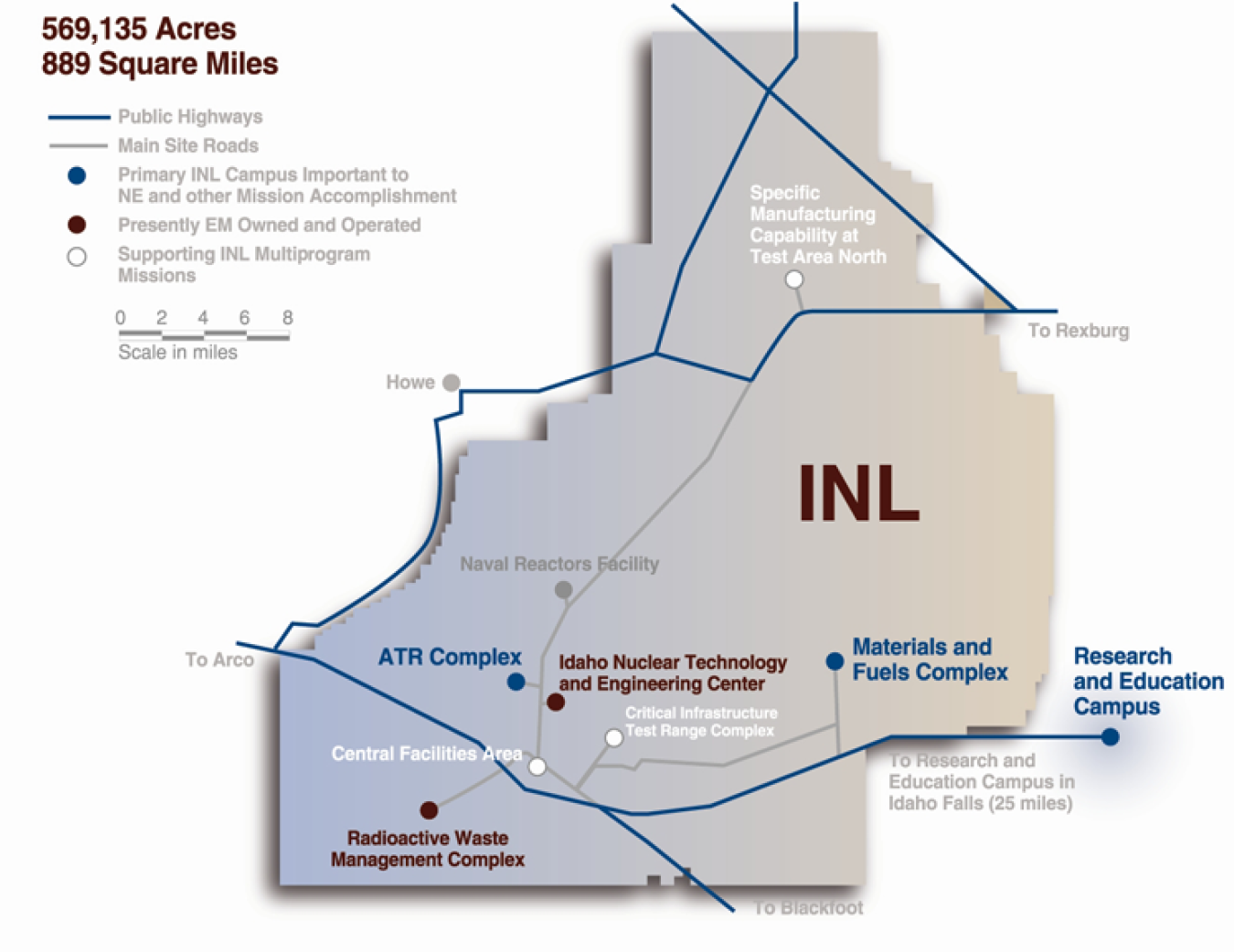
INL is a science-based, applied engineering national laboratory dedicated to meeting the nation's environmental, energy, nuclear technology, and national security needs.
The Idaho Operations Office oversees these contract activities in accordance with DOE directives.
INL is a Multiprogram Laboratory
In addition to enabling the Office of Nuclear Energy to develop space power systems and advanced fuel cycle and reactor technologies, INL facilities are used by the National Nuclear Security Administration and other DOE offices, together with other federal agencies such as the Department of Defense and Department of Homeland Security, to meet an array of strategic energy, environmental, and national security goals.
The INL includes an 889-square-mile high desert site with two main on-site technology areas: the Materials and Fuels Complex (MFC) and the Advanced Test Reactor Complex (ATRC). A third technology area, the Research and Education Campus (REC), is in the City of Idaho Falls.
The INL is comprised of 890 square miles that include 228 buildings, more than 1,000 structures, roads, railroads, transmission lines, and a full complement of utilities and services. These systems connect and serve the primary technology complexes, and therefore represent a critical investment in sustaining INL’s research capabilities.
Materials and Fuels Complex (MFC)
MFC supports important national goals and is the INL’s center for fuel fabrication and post irradiation testing. Its facilities are required for advanced nuclear energy technology research and development and other initiatives. Maintaining mission-essential infrastructure at MFC requires: safety and securely managing special nuclear materials; responsibly managing and disposing of legacy materials generated by past DOE nuclear energy activities; strategic modernizing of facilities; and deactivating unneeded facilities.
Major MFC facilities include the following:
- Hot Fuel Examination Facility
- Fuel Conditioning Facility
- Fuel Manufacturing Facility
- Analytical Laboratory
- Electron Microscopy Laboratory
- Radiochemistry Laboratory (RCL)
- Neutron Radiography Reactor
- Space and Security Power Systems Facility
ATR Complex (ATRC)
ATRC contains important assets, primary of which is the Advanced Test Reactor (ATR), used to support national security goals. Test reactors, laboratories, hot cells and supporting facilities have been operated at this site since the early 1950s. The reactors currently operating are the ATR and the ATR-Critical Facility (ATRCF)
In addition to the Office of Nuclear Energy R&D programs, key uses of the ATR and ATRCF are the Office of the Deputy Administrator for Naval Reactors within the Department’s National Nuclear Security Administration (NNSA).
ATR was designated as a National Scientific User Facility in April 2007. As a user facility, ATR is available to researchers from universities and industry for conducting in-core experiments vital to nuclear energy technology and materials development. ATR availability for research is managed under the NE National Scientific User Facility Program, which enables facilities and capabilities at all three of INL’s technology areas -- MFC, ATRC, and REC -- available to researchers for use in scientific experiments that have strong potential to achieve breakthroughs in basic and applied science and to help improve the performance of the nation’s current fleet of commercial light water reactors.
As a key element of the NE National Science User Facility Program at INL, ATR will help INL become a cornerstone of nuclear energy R&D conducted by universities, industry, international organization, and other laboratories, with the overall goal of enhancing U.S. energy security.
Research and Education Campus (REC)
The REC is the collective name for INL's administrative, technical support and computer facilities in Idaho Falls, as well as the in-town laboratories where researchers work on a wide variety of advanced scientific research and development projects. These efforts support nuclear research, national security programs and a wide range of cutting-edge research in fields as varied as robotics, genetics, biology, chemistry, metallurgy, computational science and hydropower.
The Center for Advanced Energy Studies (CAES), which opened in 2009, houses the Energy Policy Institute, and is an important resident program at REC. CAES creates a unique and collaborative environment for addressing the nation's energy future, including cross-organizational and peer-to-peer technical collaboration. Its goal is to address science, engineering and technology development critical to U.S. and global energy needs. CAES research will focus on energy affordability, environmental safety, and technology research in nuclear, hydrogen, and fossil fuels (coal, oil and gas), plus the full spectrum of renewable energy sources.

